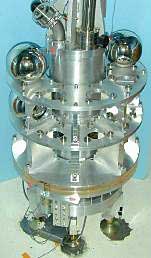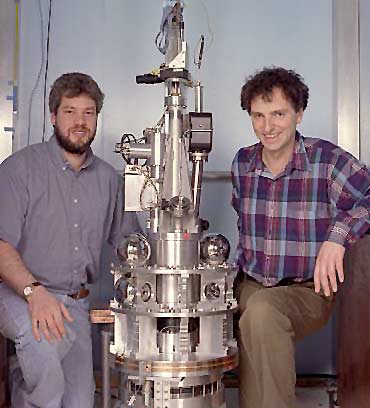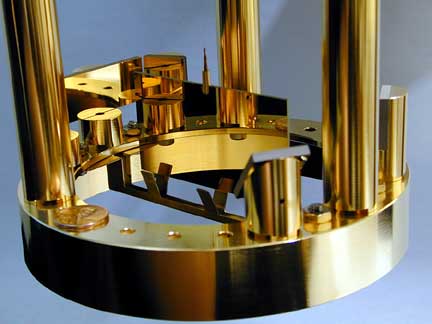Big 'G'
In 1665, Isaac Newton recognized that all matter attracts all other matter, but he also recognized that the gravitational attraction of everyday objects for each other was far too small to be measured in his time. Newton tested his theory of gravitation with the large masses of astronomical objects like the moon, Earth, and sun.
Dependence on mass and separation

Photo of University of Washington experiment showing polished spheres
Newton discovered that all matter in the universe attracts all other matter, with a force that decreases with the square of the separation. If you double the separation of two objects, the force they exert on each other is divided by four.
The force is proportional to the mass of each object. Double the mass of one object, and the gravitational force doubles, too.
We make an equation.
So far we have that for the force of gravity F between two objects, 1 and 2,
| F is proportional to | M1M2 |
| R2 |
In the above relationship, M1 and M2 are masses, R is the separation between them. To make this relationship into an equation, we need a constant, fondly known as “Big ‘G’”. Here's the equation:
| F = | GM1M2 |
| R2 |
Notice that if R gets big, the value of F gets small.
Why “Big ‘G’” is important
If we know "G" from lab measurements, we can find the mass of Earth by measuring the radius of the moon's orbit and the length of the month, or by measuring the acceleration of gravity on Earth's surface. Likewise, we can find the mass of the sun by measuring Earth's orbit and determining the length of the year.
Science Marches Ahead?
We expect measurements to get more and more accurate over time, as physicists improve experiments and employ new technologies. With "Big 'G'", however, for a while the accuracy was going down, and fast. Prior to 1987, "Big 'G'" was taken to be accurate to 0.013%. Subsequently, two research groups made measurements that were tenths of a percent from the then-accepted value, and in different directions! Consequently the accepted uncertainty was raised by more than a factor of ten. This unfortunate situation galvanized several other groups into action, including one at the University of Washington, whose measurements are accurate to 0.0015%, nearly 10 times more accurate than the 1987 value.
Measuring Big 'G'
Big news at an April 2000 scientific meeting was the announcement of a long-awaited higher precision measurement of the gravitational constant (affectionately known as “Big ‘G’”among physicists) by Jens Gundlach of the University of Washington. Although G has been of fundamental importance to physics and astronomy ever since it was introduced by Isaac Newton in the seventeenth century (the gravitational force between two objects equals G times the masses of the two objects and divided by their distance apart squared), it has been relatively hard to measure, owing to the weakness of gravity.

Steve Merkowitzz (l) and Jens Gundlach (r) with the Cavendish apparatus developed at the University of Washington. (Credit: Mary Levin, University of Washington)
The UW group has reduced the uncertainty in the value of G by almost a factor of ten. Their preliminary value is G=6.67390 x 10-11 m3/kg/s2 with an uncertainty of 0.0014%. Combining this new value of G with measurements made with the Lageos satellite (which uses laser ranging to keep track of its orbital position to within a millimeter) permits the calculation of a brand new, highest precision mass for the earth: 5.97223 (+/- .00008) x 1024 kg. Similarly the new mass of the sun becomes 1.98843 (+/- .00003) x 1030 kg.
According to Gundlach, the setup is not unlike Cavendish's venerable torsion balance of two hundred years ago: a hanging pendulum is obliged to twist under the influence of some nearby test weights. But in the Washington experiment measurement uncertainties are greatly reduced by using a feedback mechanism to move the test weights, keeping pendulum twisting to a minimum.
Another team of scientists at the University of Washington has succeeded in measuring gravity at the submillimeter scale for the first time. The force has long been studied over planetary distances but is more difficult to gauge at the terrestrial scale, where intrusive electric and magnetic fields, many orders of magnitude stronger than gravity fields, can be overwhelming. Nevertheless, Eric Adelberger and his UW colleagues have managed to measure the force of gravity over distances as small as 150 microns using a disk-shaped pendulum carefully suspended above another disk, with a copper membrane stretched between them to help isolate electrical forces.
The subject of short-range gravity has recently attracted much theoretical and experimental interest owing to a relatively new model which supposes the existence of extra spatial dimensions in which gravity, but not other forces, might be operating. According to Nima Arkani-Hamed of LBL, this is why gravity is so weak: it dilutes itself in the extra dimensions. In other words, ordinary particles are tethered to our conventional spacetime, or "brane," while gravitons are free to roam into otherwise unseeable dimensions.
One implication of the model, testable with tabletop experiments such as Adelberger's, is that the gravitational force might depart from Newton's inverse square law (gravity inversely proportional to the square of the distance between two objects) at close range. Adelberger did not observe such a departure at distances down to tenths of a millimeter and will continue to explore even shorter distances. (For a list of tabletop experiments underway, see http://gravity.phys.psu.edu/mog/mog15/node12.html.)
Links
University of Washington
Bicentenary of the Cavendish Experiment Conference
University of Michigan
Iowa State University

The pendulum from the Big "G" experiment at the University of Washington. Credit: John Amsbaugh, University of Washington














